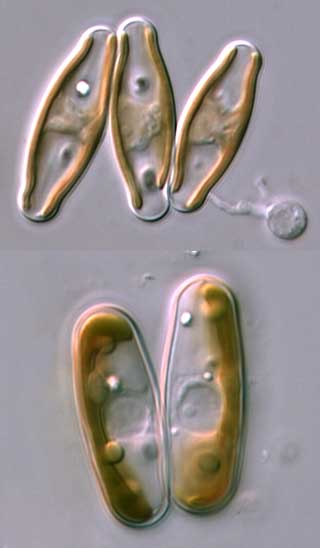Sellaphora: a model system

The freshwater pennate diatom Sellaphora
We are using Sellaphora as a model system for studying many aspects of diatom biology, systematics and evolution. In this part of the Sellaphora Website, we will explain how and why we began to study Sellaphora and why it is a good model organism. The two photographs show mating cells of two species of Sellaphora. These two examples - a triplet of S. auldreekie and a pair of S. blackfordensis - were photographed from the same semi-natural population from Lochend Loch, Edinburgh. Although the species are closely related and occurred together in the same habitat, there is no tendency for them to interbreed. It was observations like this that first led us to study Sellaphora and adopt it as a model system. [Note also the fungal parasite growing towards the triplet of S. auldreekie].
Model systems are used because it is impossible to make detailed studies of every species on earth. Instead, particular species are chosen that are convenient for analysis and experimentation in relation to particular research fields - the fungus Neurospora for genetic analysis, the garden weed Arabidopsis for plant development, and so on. Some model organisms, such as the fruit-fly Drosophila, are now so well-studied that they can be used for a huge range of research questions. The draw-back of model systems is that the model organism may not be representative of the group to which it belongs. Indeed, they are often atypical, being selected for characteristics that make them handy as laboratory tools (convenient size, short generation time, easy culture, visibility of the traits under study, etc). In diatoms, several models have been developed. Phaeodactylum tricornutum is one of the best known of these and its whole genome has now been sequenced, but this is one of the most aberrant diatoms known, having a unique cell wall structure and lacking the size-related sexualization characteristic of other diatoms.
So, what makes Sellaphora a good model system, and for what? please continue:

 This site is hosted by the Royal Botanic
Garden Edinburgh.
This site is hosted by the Royal Botanic
Garden Edinburgh.